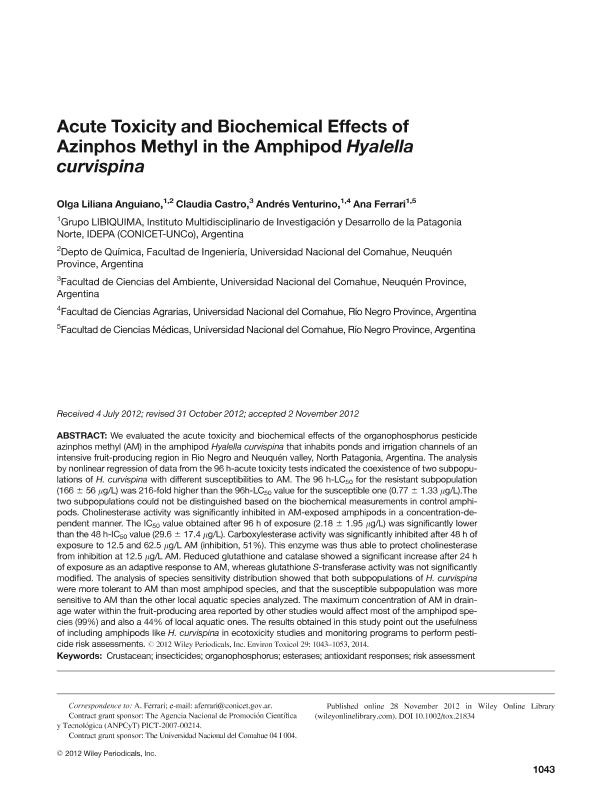Mostrar el registro sencillo del ítem
dc.contributor.author
Anguiano, Olga L.
dc.contributor.author
Castro, Claudia Magdalena

dc.contributor.author
Venturino, Andres

dc.contributor.author
Ferrari, Ana

dc.date.available
2017-01-17T21:27:39Z
dc.date.issued
2014-09
dc.identifier.citation
Anguiano, Olga L.; Castro, Claudia Magdalena; Venturino, Andres; Ferrari, Ana; Acute toxicity and biochemical effects of azinphos methyl in the amphipod Hyalella curvispina; Wiley Blackwell Publishing, Inc; Environmental Toxicology; 29; 9; 9-2014; 1043-1053
dc.identifier.issn
1520-4081
dc.identifier.uri
http://hdl.handle.net/11336/11529
dc.description.abstract
We evaluated the acute toxicity and biochemical effects of the organophosphorus pesticide azinphos methyl (AM) in the amphipod Hyalella curvispina that inhabits ponds and irrigation channels of an intensive fruit-producing region in Rio Negro and Neuque´ n valley, North Patagonia, Argentina. The analysis by nonlinear regression of data from the 96 h-acute toxicity tests indicated the coexistence of two subpopulations of H. curvispina with different susceptibilities to AM. The 96 h-LC50 for the resistant subpopulation (166 6 56 lg/L) was 216-fold higher than the 96h-LC50 value for the susceptible one (0.77 6 1.33 lg/L).The two subpopulations could not be distinguished based on the biochemical measurements in control amphipods. Cholinesterase activity was significantly inhibited in AM-exposed amphipods in a concentration-dependent manner. The IC50 value obtained after 96 h of exposure (2.18 6 1.95 lg/L) was significantly lower than the 48 h-IC50 value (29.6 6 17.4 lg/L). Carboxylesterase activity was significantly inhibited after 48 h of exposure to 12.5 and 62.5 lg/L AM (inhibition, 51%). This enzyme was thus able to protect cholinesterase from inhibition at 12.5 lg/L AM. Reduced glutathione and catalase showed a significant increase after 24 h of exposure as an adaptive response to AM, whereas glutathione S-transferase activity was not significantly modified. The analysis of species sensitivity distribution showed that both subpopulations of H. curvispina were more tolerant to AM than most amphipod species, and that the susceptible subpopulation was more sensitive to AM than the other local aquatic species analyzed. The maximum concentration of AM in drainage water within the fruit-producing area reported by other studies would affect most of the amphipod species (99%) and also a 44% of local aquatic ones. The results obtained in this study point out the usefulness of including amphipods like H. curvispina in ecotoxicity studies and monitoring programs to perform pesticide risk assessments.
dc.format
application/pdf
dc.language.iso
eng
dc.publisher
Wiley Blackwell Publishing, Inc

dc.rights
info:eu-repo/semantics/openAccess
dc.rights.uri
https://creativecommons.org/licenses/by-nc-sa/2.5/ar/
dc.subject
Crustacean
dc.subject
Insecticides
dc.subject
Organophosphorus
dc.subject
Esterases
dc.subject
Antioxidant Response
dc.subject
Risk Assessment
dc.subject.classification
Otras Ciencias Biológicas

dc.subject.classification
Ciencias Biológicas

dc.subject.classification
CIENCIAS NATURALES Y EXACTAS

dc.title
Acute toxicity and biochemical effects of azinphos methyl in the amphipod Hyalella curvispina
dc.type
info:eu-repo/semantics/article
dc.type
info:ar-repo/semantics/artículo
dc.type
info:eu-repo/semantics/publishedVersion
dc.date.updated
2017-01-17T19:22:01Z
dc.identifier.eissn
1522-7278
dc.journal.volume
29
dc.journal.number
9
dc.journal.pagination
1043-1053
dc.journal.pais
Estados Unidos

dc.journal.ciudad
Nueva York
dc.description.fil
Fil: Anguiano, Olga L.. Universidad Nacional del Comahue. Facultad de Ingenieria. Departamento de Quimica; Argentina. Instituto Multidisciplinario de Investigación y Desarrollo de la Patagonia Norte; Argentina
dc.description.fil
Fil: Castro, Claudia Magdalena. Universidad Nacional del Comahue. Facultad de Cs.del Ambiente y la Salud; Argentina. Consejo Nacional de Investigaciones Científicas y Técnicas; Argentina
dc.description.fil
Fil: Venturino, Andres. Universidad Nacional del Comahue. Facultad de Ciencis Agrarias; Argentina. Instituto Multidisciplinario de Investigación y Desarrollo de la Patagonia Norte; Argentina. Consejo Nacional de Investigaciones Científicas y Técnicas; Argentina
dc.description.fil
Fil: Ferrari, Ana. Instituto Multidisciplinario de Investigación y Desarrollo de la Patagonia Norte; Argentina. Universidad Nacional del Comahue; Argentina. Consejo Nacional de Investigaciones Científicas y Técnicas; Argentina
dc.journal.title
Environmental Toxicology

dc.relation.alternativeid
info:eu-repo/semantics/altIdentifier/url/http://onlinelibrary.wiley.com/doi/10.1002/tox.21834/abstract
dc.relation.alternativeid
info:eu-repo/semantics/altIdentifier/url/http://dx.doi.org/10.1002/tox.21834
Archivos asociados
